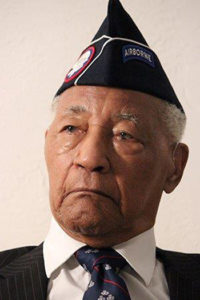
Walter Morris
*Walter Morris was born on this date in 1921. He was a Black Paratrooper and Brick Mason Supervisor.
From Waynesboro, Ga., he was the youngest and only male of seven children. After graduating from high school, he began an apprenticeship as a bricklayer, but he found construction work sparse during the Depression. He joined the Army as a one-year volunteer in January 1941. After the Japanese attack on Pearl Harbor that December, Morris continued his Army service as a clerk.
In 1943, he “washed out” of Infantry Officer Candidate School on the 12th week of a 13-week program. He was relegated to guarding the parachute school at Fort Benning, Ga., with fellow Black soldiers from 4 p.m., when the white paratrooper trainees left the field until the students returned at eight the next morning.
At the time, the morale of Blacks was miserable. The post was largely segregated, including its movie theater and exchange. In 2013, he told the Daytona Times newspaper in Florida, “When we walked past the post exchange, we could see the German and Italian prisoners sitting at tables . . . drinking and smoking, and we, in the same uniforms, could not go in.”
Under Morris’s command, the men voluntarily began a daily regimen of strenuous calisthenics similar to white paratroopers. He thought I knew how to lead men because he had just missed becoming an officer in the United States Army by one week.” His commanding officer, Lt. Gen. Ridgely Gaither, of the parachute school, drove by one day and saw “50 Black soldiers jumping up and down shouting, ‘One thousand one, one thousand two.’ He didn’t know what to make of it, so he called me to his office.”
Gaither then confided in him that a new, all-Black parachute company was being formed, and the general invited Morris to be the first sergeant in the outfit. Morris completed O.C.S. in August 1944 and was the only Black student in his class at Adjutant General School. During World War II, Morris became one of the first Black paratroopers in the Army, an original member of the all-black 555th Parachute Infantry Company, which was activated on Dec. 30, 1943.
Toward the war's end, they were tapped for a secret mission called Operation Firefly. While on a westbound train in May 1945 from Camp Mackall, N.C., then-1st Sgt. Morris thought he and the men under his command were headed to the Pacific to join up with Gen. Douglas MacArthur. Instead, Morris played a pivotal role in a little-remembered theater of war: the Pacific Northwest. As a smoke jumper, he parachuted out of airplanes to extinguish forest fires in remote areas that would take days to reach by foot.
The weapon they used most was a shovel to dig trenches to control or stop the spread of deadly fires. The Triple Nickles, as they were called, became the 555th Parachute Infantry Battalion. They responded to more than 30 domestic fires and made more than 1,000 individual jumps between 1943 and 1947. They were augmenting the U.S. Forest Service’s smoke-jumper program, which had been in effect for several years.
Morris noted, "None of the commanding generals wanted to accept the Black battalion because it meant integration, which had never been done.” By the time the 555th arrived in Oregon, the threat of Japanese incendiary “balloon bombs” had largely ceased. Starting in November 1944, Japan sent more than 9,000 such bombs across the Pacific, carried by trade winds. A small portion reached the United States. A balloon that exploded on May 5, 1945, at their picnic site near Bly, Ore, killed five children and a minister’s wife.
Morris and his men mostly leaped out of planes to quell fires started by lightning, thoughtless campers, or arsonists. They underwent rigorous training, learning to use demolition equipment, climb trees, and get out of a tree if a jumper got tangled with heavy gear during the descent. There was also training in avoiding ugly encounters with bears and rattlesnakes, which vied for the food dropped into the wilderness by parachute.
He married His first wife, Ruby Lovette, in 1944. Lieutenant Morris was honorably discharged in 1946 and headed to Seattle to continue his bricklaying apprenticeship for his father’s business. In 1948, three years after the war ended, President Harry S. Truman signed an executive order desegregating the military. Morris told the Associated Press decades later, “We didn’t win any wars, but we did contribute; what we proved was that the color of a man had nothing to do with his ability.”
In 1950, he worked in New York as a union bricklayer and, moving forward, a foreman in 1965, supervising 15 to 25 bricklayers to put up schools and libraries. Morris was appointed construction supervisor as part of the Bedford-Stuyvesant Restoration Corporation Project, initiated by Senator Robert F. Kennedy in 1976 to restore Brooklyn’s inner city housing. He was involved with all the trades for completing the 104-unit apartment complex and the Restoration Mall for the offices of Congresswoman Shirley Chisholm. In 1979, Morris married Irma Page. She died in 1999.
Morris, who spent his postwar career as a bricklayer in North Carolina and then a construction project supervisor in New York, settled in Florida in the mid-1980s. Walter Morris had four children and was a resident of Palm Coast, where he died at a hospital on October 19, 2013, at the age of 92. The cause was cardiac arrest.
To Have a Military Career